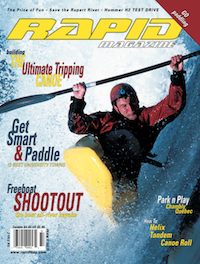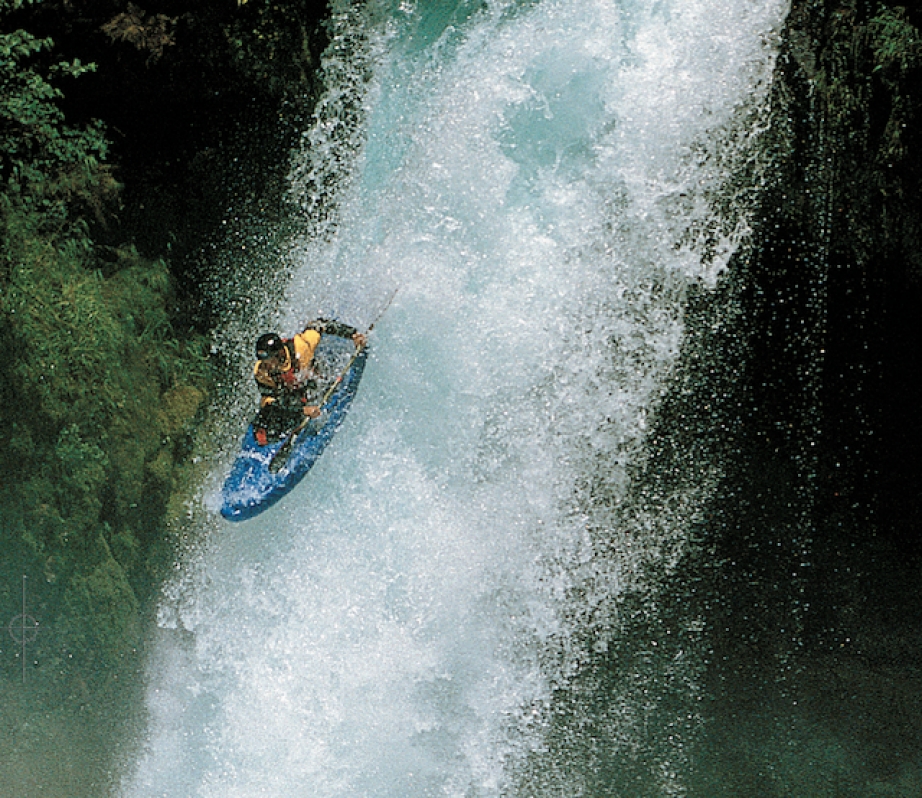Your goal when running big drops is to find the entry angle that will keep your back and body safe from impact but not hit any submerged rocks or the river bottom. The best way to learn to run waterfalls is to start off on smaller, relatively safe drops and work up to harder and bigger. The higher the drop, the more likely you are to want to pencil.
Pencilling is when your boat pitch matches that of the falling curtain of water and you drop into the pool vertically, rather than flat like a boof. It will take time and practice to confidently line up, launch and safely land big drops, but what feels at first like a big blur will soon become familiar and slower. You’ll develop the consciousness to open your eyes, make fine adjustments and enjoy the ride.
SCOUTING THE DROP
You should be scouting and running safety for all big drops. Look through the whole drop to see if there is any one part that is obviously unrunnable. If this is the case, begin hiking around or decide if you can either put in just below or get out just above the nastiness.
Be sure of your landing zone and that you can hit it. A safe landing zone is often the reason a drop is runnable or not.
Generally, the more aerated the water the higher you can get away with landing flat. Is your landing big, foamy and soft or is flat, green and hard? Is it too high to boof?
How deep is the pool? Is it deep enough to pencil? The best way to find out is to actually go down and check with a pole or a big stick, or even get into the water and look around. However, this is not always realistic and is rarely necessary. With practice and experience you will be able to roughly gauge the pool depth and location of rocks by looking at the foam pile and boils. Another good way to know for sure is to check when the water’s not flowing and return the next season or, in some cases, the next day when the dam releases.
What other dangers are there? Often wood and other debris will collect in the pool below large waterfalls. On sheer drops the river may not only pound away and erode the base of the falls but also the wall behind it creating a cave hazard. Be sure that you can
either get out from behind the falls or be positive you will finish on the downstream side.
Consider the water depth at the lip of a drop. If you barely scrape over the lip of a sheer drop, it is very easy to get hung up and go over vertical, not so gracefully flopping your 30 footers onto your head.
Be sure you’ll see your intended line from your boat at river level. Use whatever landmarks are avail- able: bridge pilings, tiny breaking waves or even a friend standing by running safety. Many paddlers (even good ones) have, in the excitement, quickly scouted a drop from shore, hopped in their boat and totally lost sight of a perfect and relatively simple line.
OFF THE LIP
To pencil off a big drop, go off at roughly the same speed as the water using only smooth correction strokes to keep the boat on line. Carrying a lot of speed off a drop may launch you ahead of the water and free of the falls, and maybe over the hole or a rock at the bottom, but it makes setting your pitch far more difficult. You want your boat to fall off the brink,
match the pitch of the water and enter the pool at the same angle as the falls.
For the most part, your body position at the brink of the drop sets your angle for the rest of the ride. Keep your body relatively neutral, leaning neither too far forward or back. On the way down, pulling your legs to your chest will cause the bow to rise and your boat to flatten. Conversely, pushing your legs away will drop the bow or cause the boat’s pitch to steepen—become more vertical.
These sound like great tricks but in reality are very difficult and take lots of practice.
What to do with your paddle? You do not want your paddle at the same level as your face or neck when hitting the water. Some boaters put their paddles to the side, parallel to the boat, and tuck their heads at the last minute. Others simply keep their blades low around their hips. Avoid the ever-popular and danger- ous skull and crossbones. Throwing your arms above your head leads to: losing at least one hand from the paddle; getting slammed to the back deck; and likely damaging a shoulder.
TOUCHDOWN
Where there is even the slightest chance of hitting rock, using anything other than a creek boat is asking for trouble. Creek boats will by no means make you invincible but are far better equipped to protect you and make the lines you choose easier to hit.
Lean forward as you pencil into the pool. This helps stop the boat from back looping and sheds some of the impact of the fall from your body.
Accidentally landing too flat? Lean forward to help protect your back. And reach for a stroke upon landing to help you move downstream away from the curtain. When landing inadvertent big boofs, turn your head to help you steer clear of a broken nose compliments of your cockpit rim.
Be comfortable surfing in holes. Playing and practicing in holes makes for a fast and bomber roll, teaches you how to manoeuvre and more importantly how to get out if that’s where you end up.
PRACTICE AND JUDGEMENT
Running big drops is a lot of fun but takes practice and good judgement. There are as many ways to get into trouble as there are ways to run waterfalls. Take rescue courses and always paddle with like-minded boaters whom you trust.
If you cannot set up adequate safety for a big drop, don’t run it. Remember, there is no hurry. The waterfall you are so intent on running today will be there to run next season, or the next.
 This article first appeared in the Summer 2003 issue of Rapid Magazine.
This article first appeared in the Summer 2003 issue of Rapid Magazine.




